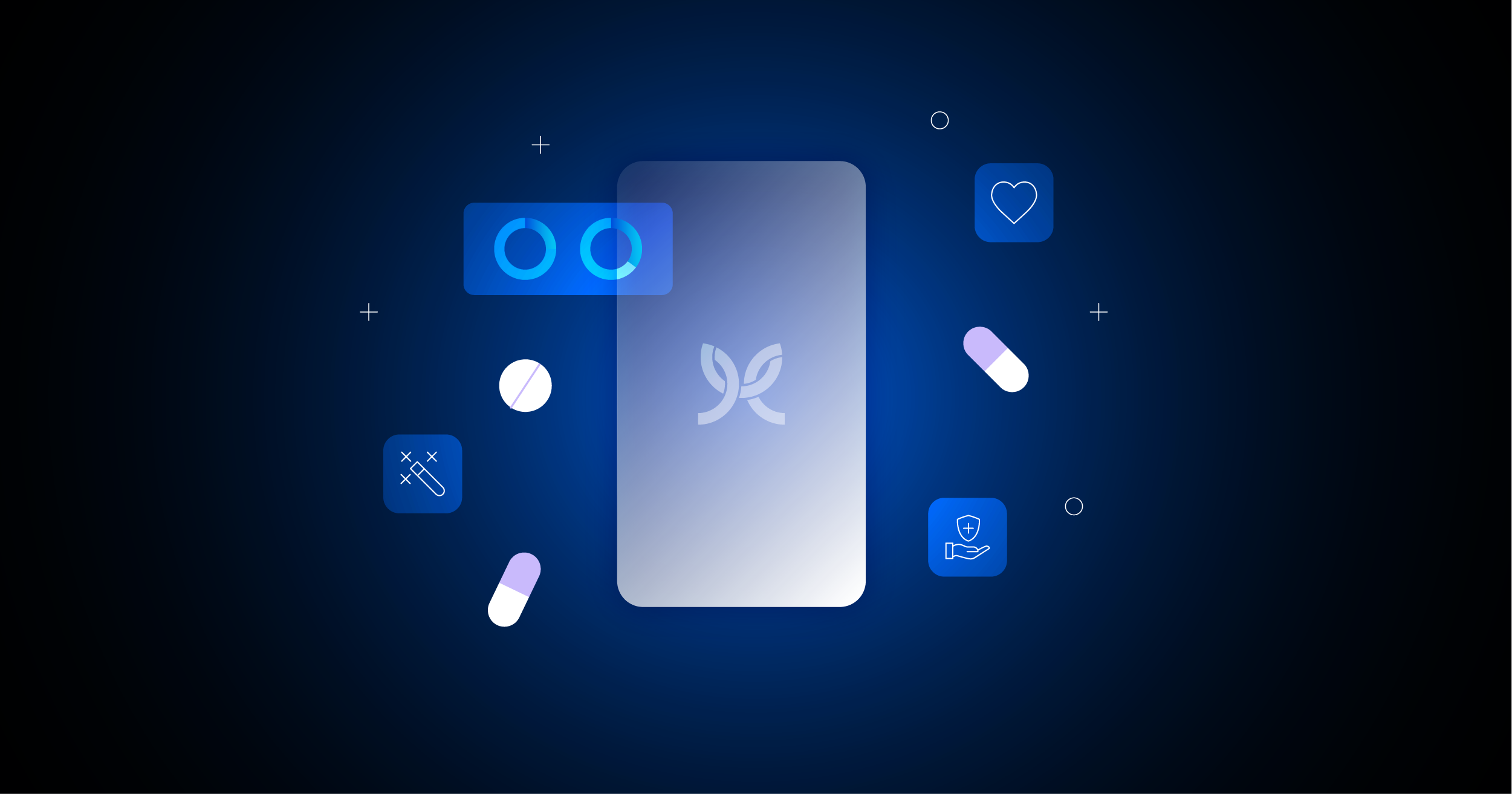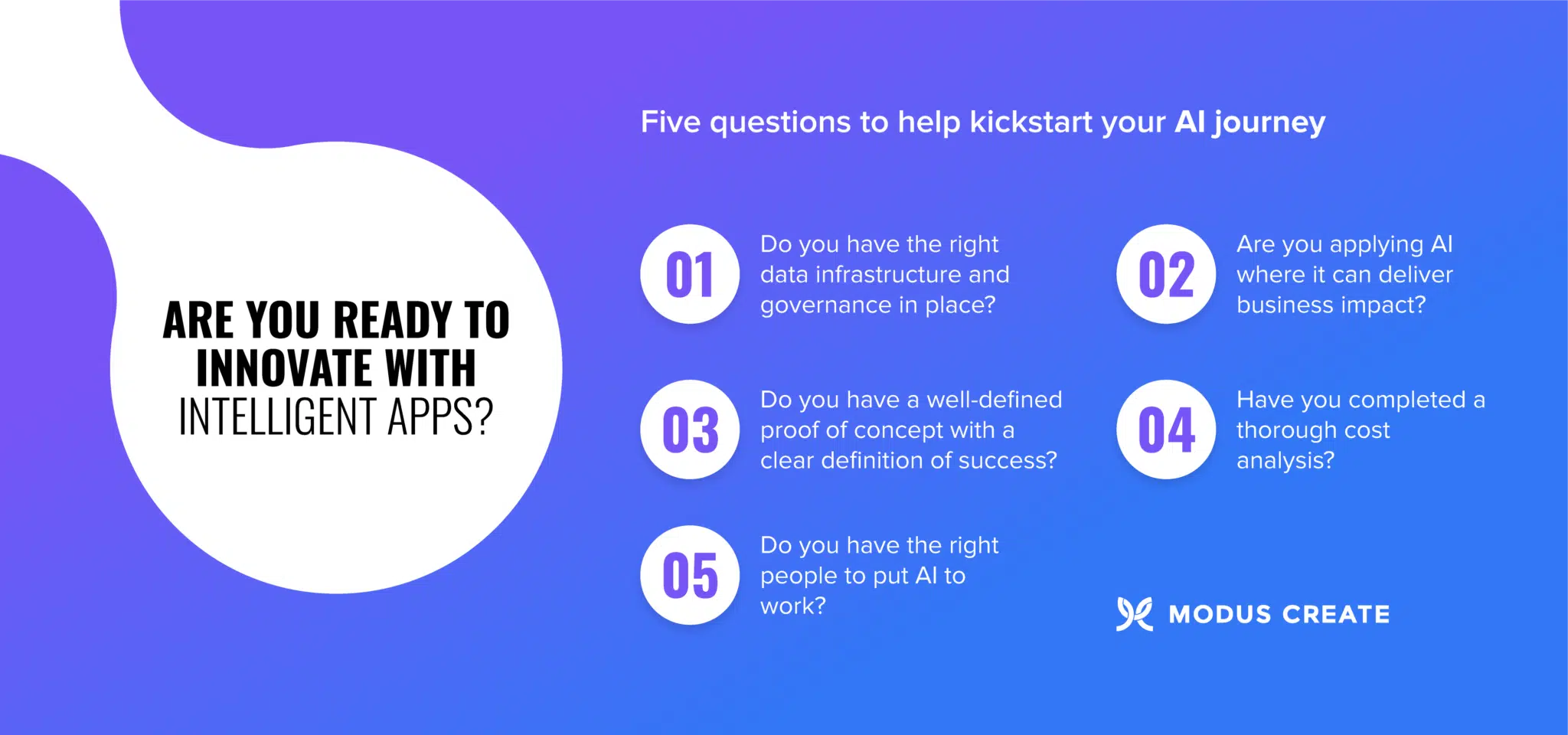Are you ready to transform life sciences with intelligent apps? Five questions to help kickstart your AI journey


Table of contents
Subscribe via Email
Subscribe to our blog to get insights sent directly to your inbox.
Few industries stand to gain as profoundly from AI advancements as life sciences.
McKinsey has estimated that AI technology could generate $60 billion to $110 billion per year in economic value for the pharma and medical-product subsectors alone. With the average cost of developing a new drug at approximately $2.3 billion, streamlining and automating clinical development processes are perfect use cases for AI.
AI use cases are enabled by intelligent applications – software applications that incorporate generative, classification, and predictive AI models under the hood to power one or more of their features.
In life sciences, intelligent apps have the clear potential to pave the way for groundbreaking innovations that improve patient care and outcomes. With savvy implementation, AI can help companies:
- accelerate drug discovery and development
- design more efficient clinical trials
- tailor personalized patient treatment
- and root out inefficiencies in data-driven tasks
But as we’ve seen in the early days of AI experimentation, moving too fast without a clear strategy roadmap will result in multiple pilots that fall short of expectations. The appetite for throwing money at AI just to get in the game has waned. Executives and boards are expecting clear returns and outcomes from their investments.
How to determine your life science organization’s AI readiness
You understand your organization should take advantage of AI, but how do you begin?
An important first step for any executive is to complete a self-assessment of your readiness to deploy intelligent apps and take advantage of all that AI has to offer life sciences. Here are five questions to ask.
1. Do you have the right data infrastructure and governance in place?
The AI innovation we're seeing from our clients in life sciences is due in part to the abundance of data available in the industry. There are many opportunities to improve upon complex, manual, expensive, and time-consuming processes.
Data quality
To get the most out of AI, it must be tuned to or trained for your specific needs using your data. Yet, numerous companies often encounter setbacks or outright failures attributable to data maturity-related issues. These challenges manifest in various forms, from poor data quality and reliability to inaccessible data sources, stemming from disparate systems and a lack of governance.
Data quality is fundamental to any AI project. When data is hard to find, access, understand, or trust, it blocks any AI initiative. On the other hand, successful AI projects are often the result of a healthy company-wide data infrastructure and governance.
With savvy implementation, AI can help life science companies accelerate drug discovery and development, design more efficient clinical trials, tailor personalized patient treatment, and root out inefficiencies in data-driven tasks, among other game-changing advancements.
Data quantity matters, too. Do you have large enough datasets with relevant data to train your models to address the problem you aim to solve?
Data compliance and consistency
In addition, you should consider compliance and privacy regulations. Ensure that best practices for data usage are met. In life sciences, there are often concerns about how sensitive patient information is handled, and regulations like HIPAA to keep in mind.
Lastly, data must be in a consistent format and made available so that it can be integrated seamlessly with AI tools and platforms. We advise our clients to:
- catalog data sources
- assess their quality
- establish a data governance framework
- ensure data is accessible to the right people and the right systems
Remember: Any AI initiative is only as good as the data supporting it.
2. Are you applying AI where it can deliver business impact?
Like any initiative, AI projects should generate an impact on the top or bottom line that is greater than the investment required. Chances are, you already have a prioritized set of one-to-three-year business strategies designed to improve your profitability. Which of these strategies includes a problem that is well-suited for AI?
Look for areas that are data intensive and require sophisticated analysis. Involve stakeholders from different parts of the business who can help identify pain points and opportunities for AI integration. Look outside your organization for what other companies in the life sciences industry are doing for ideas and inspiration.
One example is to use AI to improve the MLR review process by automating time-consuming manual steps without removing important human oversight. LLMs assist by quickly reviewing documents, understanding and extracting claims, and presenting them in a digestible format. Not only does this save time, but it also enhances the accuracy of the review process.
When thinking about your readiness for AI, it’s important to understand the specific problem at hand. If your goal is to predict outcomes based on existing data, like patient readmission risk, traditional, discriminative AI modeling is likely the best tool for the job. However, if you want to create new content, audit a regulatory filing, or glean insights from volumes of existing research, generative AI is better suited to retrieve, aggregate, contextualize, and analyze disparate data sets.

3. Do you have a well-defined proof of concept with a clear definition of success?
ROI tracking of GenAI investments is complex. As Gartner analyst Rita Sallam points out, the life science organizations that will benefit the most from AI deployments first “build a business case by simulating potential cost and value realization across a range of GenAI activities.”
Among the activities that Sallam identifies are:
- quick wins that focus on productivity improvements
- differentiating initiatives that provide a competitive advantage
- more transformative initiatives where, as Sallam puts it, “innovators may have to accept difficult-to-quantify hard financial returns and higher cost, complexity and risk in exchange for first-mover advantage.”
Depending on the initiative, the definition of success might include revenue increases, cost savings, productivity gains, or the accuracy of predictive models.
How life sciences organizations can use AI
According to Deloitte, one area that life sciences can benefit from is research and clinical development. You can use GenAi to identify targets, develop molecules, accelerate clinical trials, and submit findings for regulatory approval. In addition, some life sciences organizations are using it to generate marketing content that appeals to customer needs.
Our recommendation: Start with a proof of concept that is narrow in scope and can deliver quick learning without a huge upfront investment. Success criteria should be clear, objective, and determined upfront. Focus on mitigating the riskiest factor in your initiative. It might be model accuracy or something entirely different like user trust.
Overall, it’s better to learn quickly and fail fast than to make a large investment, bring an intelligent app straight to production, and find out that there’s a preventable conceptual flaw.
4. Have you completed a thorough cost analysis?
Implementing an enterprise AI project involves capital investment and various operating costs that should be evaluated before launching any initiative.
Depending on your internal IT resources, these costs might include:
- upfront software development
- expenses related to data cleaning and preprocessing
- licensing for third-party AI platforms
- inference costs associated with running your models once deployed,
- other infrastructure costs for running the intelligent application on a cloud service provider platform or on-premises hardware
Understanding proof of value upfront will ensure that the AI project supports overall business goals and is budgeted adequately.
Many life science companies find it worthwhile to partner with experienced consultants who can help assess readiness and current AI capabilities, identify the best opportunities to target, close potential skills gaps, and develop a realistic blueprint for AI adoption.
5. Do you have the right people to put AI to work?
A recent report by Robert Half found that 90% of technology leaders plan to implement AI initiatives this year. Yet, 48% of them cite a lack of staff with AI skills and expertise as the biggest barrier to success.
We’ve learned firsthand from years of experience and our conversations with life sciences executives that companies with mature software development functions aren’t necessarily equipped to develop AI. The best approach is to identify the right partner with the specific skills and experience to work with your in-house teams to design and drive a project. At a minimum, enterprise-grade intelligent apps require a data scientist, AI/ML engineer, and MLOps engineer.
With established methodologies, a partner can accelerate the development of an AI PoC and avoid the pitfalls that can stall a project indefinitely. The right partnership will also help you extend the PoC to production and ultimately wide-scale implementation – where the actual value is generated.
When endeavoring an AI initiative where employee engagement and adoption are paramount, it’s crucial to document the outcomes and benefits for employees as part of a behavioral change management plan. AI can be a tool to increase employee productivity. This cuts out tedious, repetitive tasks in favor of more strategic functions best performed by humans.
The challenge is finding the right evangelists — both executives and enthusiastic first adopters in the organization who can explain these benefits to their co-workers, educate employees on the new tools, communicate the planned rollout, and set the right expectations throughout your company.
Navigate your AI journey with confidence
As an industry founded on data-driven discovery, life sciences is uniquely positioned to capitalize on the incredible power of AI. However, applying AI effectively is not a simple proposition.
Even if, after asking yourself these questions, you discover that your organization isn’t yet ready for AI, or that you lack the talent and resources to get started, there’s still a way forward.
Many companies find it worthwhile to partner with experienced consultants who can help assess readiness and current AI capabilities, identify the best opportunities to target, close potential skills gaps, and develop a realistic blueprint for AI adoption. The companies that emerge as leaders will be those that take this initial step to realize AI’s maximum business value.

Greg Sterndale is the VP, Product Engineering Services at Modus Create. A software engineer turned entrepreneur, Greg has two decades of experience, seasoned with optimism and a healthy appetite for challenges. He has led teams to launch dozens of successful digital products for innovative Fortune 500 pharma & life sciences, finance, tech, and retail companies. When he’s not building products, Greg enjoys mentoring other entrepreneurs, contributing to open source software, skiing, cycling, and most things out-of-doors.
Related Posts
Discover more insights from our blog.


